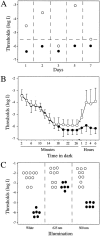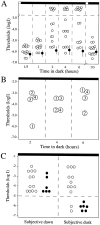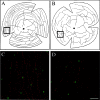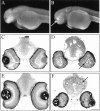Disruption of the olfactoretinal centrifugal pathway may relate to the visual system defect in night blindness b mutant zebrafish
- PMID: 10684889
- PMCID: PMC6772933
- DOI: 10.1523/JNEUROSCI.20-05-01883.2000
Disruption of the olfactoretinal centrifugal pathway may relate to the visual system defect in night blindness b mutant zebrafish
Abstract
We describe here a dominant mutation, night blindness b (nbb), which causes an age-related visual system defect in zebrafish. At 4-5 months of age, dark-adapted nbb(+/-) mutants show abnormal visual threshold fluctuations when measured behaviorally. Light sensitizes the animals; thus early dark adaptation of nbb(+/-) fish is normal. After 2 hr of dark adaptation, however, visual thresholds of nbb(+/-) mutants are raised on average 2-3 log units, and rod system function is not detectable. Electroretinograms recorded from nbb(+/-) mutants are normal, but ganglion cell thresholds are raised in prolonged darkness, suggesting an inner retinal defect. The visual defect of nbb(+/-) mutants may be likely caused by an abnormal olfactoretinal centrifugal innervation; in nbb(+/-) mutants, the olfactoretinal centrifugal projection to the retina is disrupted, and the number of retinal dopaminergic interplexiform cells is reduced. A similar visual defect as shown by nbb(+/-) mutants is observed in zebrafish in which the olfactory epithelium and olfactory bulb have been excised. Homozygous nbb fish display an early onset neural degeneration throughout the CNS and die by 7-8 d of age.
Figures








Similar articles
-
A dominant form of inherited retinal degeneration caused by a non-photoreceptor cell-specific mutation.Proc Natl Acad Sci U S A. 1997 Oct 14;94(21):11645-50. doi: 10.1073/pnas.94.21.11645. Proc Natl Acad Sci U S A. 1997. PMID: 9326664 Free PMC article.
-
Slow-progressing photoreceptor cell degeneration in night blindness c mutant zebrafish.J Neurocytol. 2003 Nov;32(9):1107-16. doi: 10.1023/B:NEUR.0000021905.33091.f1. J Neurocytol. 2003. PMID: 15044842
-
ENU-induced late-onset night blindness associated with rod photoreceptor cell degeneration in zebrafish.Mech Ageing Dev. 2003 Dec;124(10-12):1065-71. doi: 10.1016/j.mad.2003.08.004. Mech Ageing Dev. 2003. PMID: 14659595
-
Sensory Integration: Cross-Modal Communication Between the Olfactory and Visual Systems in Zebrafish.Chem Senses. 2019 Jul 17;44(6):351-356. doi: 10.1093/chemse/bjz022. Chem Senses. 2019. PMID: 31066902 Free PMC article. Review.
-
Fishing for age-related visual system mutants: behavioral screening of retinal degeneration genes in zebrafish.Curr Aging Sci. 2010 Feb;3(1):43-5. doi: 10.2174/1874609811003010043. Curr Aging Sci. 2010. PMID: 20298169 Review.
Cited by
-
STIL: a multi-function protein required for dopaminergic neural proliferation, protection, and regeneration.Cell Death Discov. 2019 Apr 25;5:90. doi: 10.1038/s41420-019-0172-8. eCollection 2019. Cell Death Discov. 2019. PMID: 31044090 Free PMC article.
-
Functional expression of SCL/TAL1 interrupting locus (Stil) protects retinal dopaminergic cells from neurotoxin-induced degeneration.J Biol Chem. 2013 Jan 11;288(2):886-93. doi: 10.1074/jbc.M112.417089. Epub 2012 Nov 19. J Biol Chem. 2013. PMID: 23166330 Free PMC article.
-
Fishing forward and reverse: Advances in zebrafish phenomics.Mech Dev. 2018 Dec;154:296-308. doi: 10.1016/j.mod.2018.08.007. Epub 2018 Aug 18. Mech Dev. 2018. PMID: 30130581 Free PMC article. Review.
-
Characterization of voltage-activated ionic currents in the GnRH-containing terminalis nerve in transgenic zebrafish.Brain Res. 2011 Jan 7;1367:43-9. doi: 10.1016/j.brainres.2010.10.024. Epub 2010 Oct 15. Brain Res. 2011. PMID: 20951681 Free PMC article.
-
Retrograde labeling of retinal ganglion cells in adult zebrafish with fluorescent dyes.J Vis Exp. 2014 May 3;(87):50987. doi: 10.3791/50987. J Vis Exp. 2014. PMID: 24837333 Free PMC article.
References
-
- Arey LB. The function of the afferent fibers of the optic nerve of fishes. J Comp Neurol. 1916;26:213–245.
-
- Baier H, Klostermann S, Trowe T, Karlstrom RO, Nusslein-Volhard C, Bonhoeffer F. Genetic dissection of the retinotectal projection. Development. 1996;123:415–425. - PubMed
-
- Branchek T, Bremiller R. The development of photoreceptors in the zebrafish, Branchydanio rerio. I. Structure. J Comp Neurol. 1984;224:107–115. - PubMed
Publication types
MeSH terms
Substances
Grants and funding
LinkOut - more resources
Full Text Sources
Molecular Biology Databases
